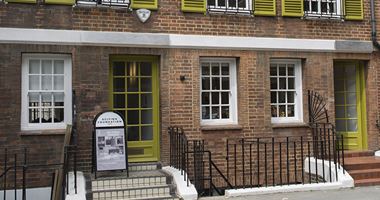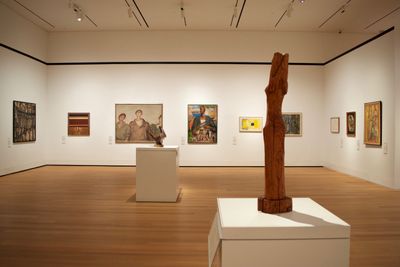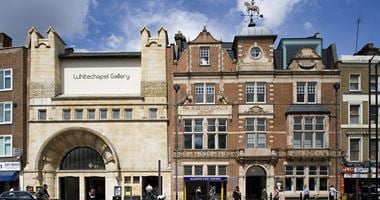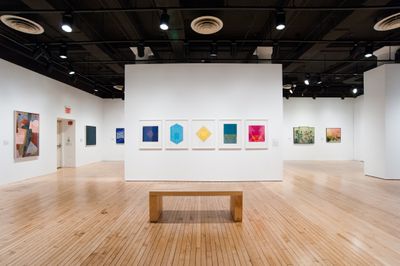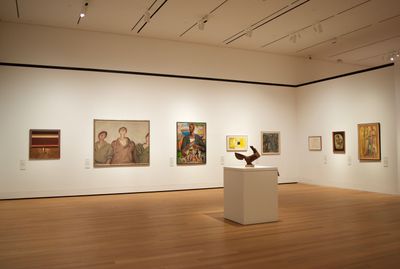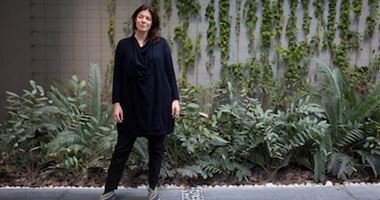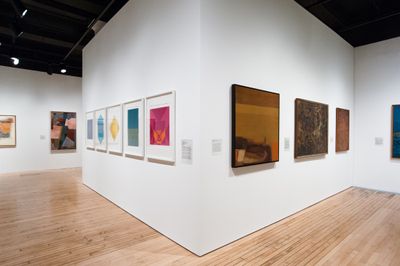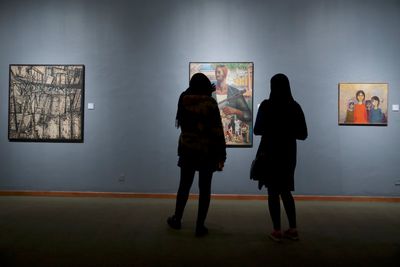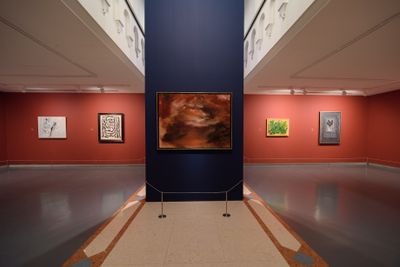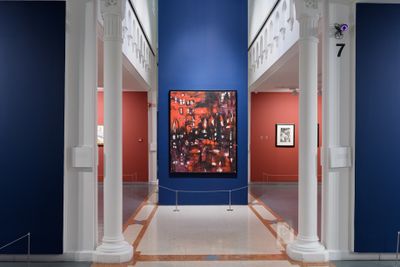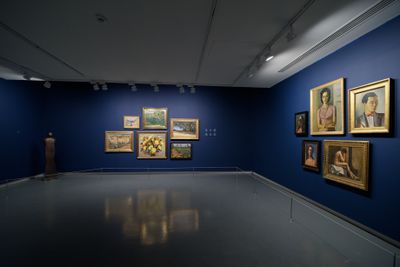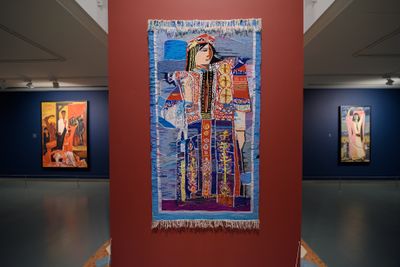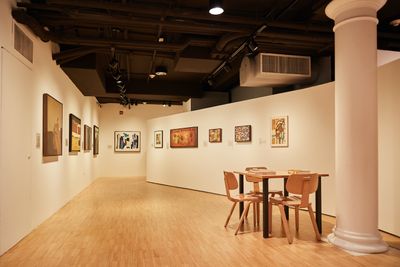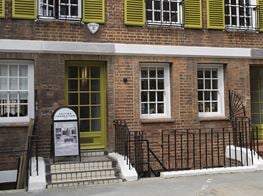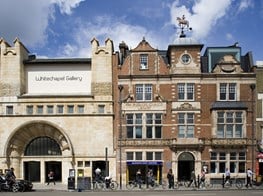Sultan Sooud Al Qassemi: Developing Art Histories
In Partnership with Delfina Foundation
Sultan Sooud Al Qassemi. Photo: Abdul Hannan.
Sultan Sooud Al Qassemi. Photo: Abdul Hannan.
Sultan Sooud Al Qassemi is the founder of the Barjeel Art Foundation, an organisation based in Sharjah, United Arab Emirates, dedicated to managing, preserving, and exhibiting an extensive collection of modern and contemporary Arab art.
Established in 2010, the Foundation maintains an exhibition programme at its base in Sharjah, and continues to engage in an extensive array of international exhibitions and projects. In 2018, the Barjeel Art Foundation signed a contract with the Sharjah Museums Authority to host a long-term exhibition of key modernist works from the Foundation's collection at the Sharjah Art Museum.
A vocal advocate of Arab culture on social media, Al Qassemi has close to 500,000 followers on Twitter and often tweets and re-tweets by the hour. As a columnist, political speaker, and social affairs analyst, he first gained visibility in 2011 during the Arab Spring, when his tweets became a major news source, and TIME magazine listed him in 'The 140 Best Twitter Feeds of 2011'.
Dissemination of thought around issues of art, culture, and knowledge production remains at the heart of Al Qassemi's activities. Through his work in writing, speaking, and art collecting, he has contributed much to the understanding of Arab modernism around the world. Although he has been away from Sharjah and the Foundation for much of the past two years, this time has not been idle. Al Qassemi took a series of teaching posts at some of America's leading academic institutions, developing a course titled 'The Politics of Modern Middle Eastern Art'. He also continued to actively work on a forthcoming publication documenting Sharjah's architecture.
The following conversation between Rose Lejeune and Al Qassemi is transcribed and edited from a Zoom call held in early May 2020, during a period of self-isolation in their respective cities of London and Sharjah. Their conversation picks up from Al Qassemi's time as collector-in-residence at the Delfina Foundation, which was part of a thematic programme curated by Lejeune called 'Collecting as Practice' that explored urgent questions around the philosophy, psychology, and politics of collecting.
During his residency, Al Qassemi contributed to discussions related to these topics, both through events organised in conjunction with the programme and, with characteristic enthusiasm, through the development of his own talks and seminars, both public and private, on contemporary politics, modern architecture, and contemporary art in the Gulf.
RLWe first met in March 2018, when you were in residence at Delfina Foundation's 'Collecting as Practice' programme. At the time, you were closing the Barjeel Art Foundation's gallery space in Sharjah, which you had been running at a breakneck pace for ten years, delivering exhibitions in the U.A.E., where you were based, and around the world. In the few years leading up to this moment, you had shows at the Tehran Museum of Contemporary Art, the Hessel Museum of Art at Bard College, Whitechapel Gallery, and the Yale University Art Gallery, among numerous others.
When we met, you were consolidating your thoughts on this decade of continuous activity. What was that moment like for you and how have your thoughts since crystallised on the Foundation's first decade?
SSAQPrior to that moment, we had to put together 15 exhibitions internationally, and I think about a dozen exhibitions locally at the Foundation in Sharjah. So I was very, very busy for the first ten years. I wanted to take a slight break, and I decided to return to the gallery space that the government of Sharjah had given me eight years earlier, and transfer the art collection to the Sharjah Art Museum on a long-term basis.
We signed an agreement with the Sharjah Art Museum in early 2018, whereby we put the works there on display for five years—where they still are now—in order to take a pause for about a year, or year and a half, from producing exhibitions. This is exactly what we did, until the opening of our show Taking Shape: Abstraction from the Arab World, 1950s–1980s (14 January–4 April 2020), which traces the emergence and development of abstraction in the Arab region, featuring nearly 90 works from the Barjeel collection. It opened at New York University's Grey Art Gallery in January 2020.
Many of our pioneers in the fields of art and architecture have no documentation whatsoever. So it's on us, as people who have the opportunity to write about them in various languages and on various platforms, to record their work.
We produced no exhibitions in 2019. Instead, we consolidated our efforts into Taking Shape. I think that gave us a bit of a breather. At the same time, I had moved to the U.S. and started teaching at Yale University and then at Georgetown University in Washington D.C., which gave me a chance to pursue the academic interests I had. This pause also gave me time to write a text for the book on modern architecture in Sharjah that, at that point, was planned to be released in 2020.
I also worked on organising a symposium on modern architecture and urbanism in the Gulf at Cambridge University in July 2019 with my colleague Roberto Fabbri, a professor of architecture at the University of Monterrey in Mexico. Around 20 scholars came together for that symposium, and from their presentations, we selected a number of papers, which will be published in an edited volume next year.
RLIt seems like a lot of your teaching and dissemination of ideas happens in the West. Why has the circulation of knowledge on the Arab world in Western contexts been a priority for you, and does it help to create new narratives within the region itself?
SSAQThat's a great question. I started teaching in the U.A.E. in 2008 at Dubai Men's College, one of the Higher Colleges of Technology. I taught there for a year and a half, until the Arab Spring began. Then Barjeel took off, and so many things happened. I was also very busy with my family business. When I was finally able to step back and let my nephew take over the family business in 2018, it allowed me to take some time for my own academic pursuits.
I really wouldn't have been able to go to NYU, Yale, Georgetown, Boston College, or do work at other universities, like MIT or Stanford, if it weren't for my nephew, who stepped in, and for my for my family who has been very supportive. Frankly, the geographic location of the institution doesn't really matter to me, because ultimately, it is the subject that gets taught. Having said that, I do go and give lectures in places around the Arab world: in Alexandria, Kuwait, Abu Dhabi, Doha, and Algiers. Whenever I'm invited to give a talk on regional art, I go.
Our exhibition at the Tehran Museum of Contemporary Art was a regional show. We had so many Iranian students come to the exhibition and say that they were familiar with the names of Arab artists, but had never seen their work in real life. They knew of Dia al-Azzawi, of Shakir Hassan Al Said, and of Etel Adnan, yet had never seen their paintings. Our show was their first opportunity to experience these works.
RLSince the lockdown, you've been hosting a really great series of Online Cultural Majlis events with artists, curators, and cultural leaders from around the world. I was listening to one a few weeks ago, with three young creatives from the Gulf: Nayla Al Khalifa, Rashed Al Nuaimi, and Raneen Bukhari, and much of the conversation focused on the need for more critical discourse in the region, both as a means of creating art histories, and as a peer-to-peer feedback mechanism.
Could you speak on the development of critical art histories in the Gulf? What are the challenges in writing art historical narratives?
SSAQThis is a packed question. It encompasses a concern that all of us have. Antonia Carver, the director of Jameel Arts Centre in Dubai, also often echoes this idea, raising it on Twitter and on Instagram. The truth is, people like Antonia have been pioneers in criticism of art and culture in the region in the English language. But we do, in fact, have critical texts written by Middle Eastern writers in Arabic and in Persian, by figures like Joseph Tarrab and Abbas Beydoun in Lebanon, Farouk Yousif in Iraq, Sobhy Sharouny in Egypt, and so many others.
The problem is that these texts aren't as accessible. Even when you publish something in a newspaper, one wonders, does the newspaper keep an archive? Does the newspaper upload these things online? Is this material searchable? Is it available? And in many cases, it's only a few people who can find and buy these books, and look up what someone else has said. This is the reality. We don't only need authors to write these texts, we need to have them digitised. I don't know how we'll do it, but I'm hopeful we'll get there. It's a process.
I believe that by the end of this decade, you'll notice that the mindset will have shifted, and a lot more books on regional art will be available in English and Arabic, reviving the field of criticism. By the way, there was a project by curators Sam Bardaouil and Till Fellrath, who will curate the next Lyon Biennale, titled 'Mapping Beirut's Art Scene 1955–1975', uploaded to the Saradar Collection's website. They have made exhibition reviews from the 1950s, 60s, and 70s available through this. How do we replicate this idea in other places—in Tehran or in Baghdad, for example?
Let me tell you something. One of my friends is a researcher in modernism in Iraq and the Levant, and he told me that one of the best libraries to research this region is in Israel. When the Israelis invaded Beirut in 1982, they took all of the Palestine Liberation Organization's archive. They also took the film archive, photo archive, newspapers, and documents. This was part of the invasion, and now it's one of the best places to research the history of the Arab world. Isn't that funny? One has to go to London to learn about Arab history, or Paris. But in the Arab world itself, there is a scarcity of information. It's ironic.
RLOne of the things you are best known for is social media. I think early on, you focused a lot more on politics before switching to art and art histories. Why are these histories so important for you to communicate?
SSAQI view Twitter as a tool to disseminate information that can become crucial in some moments, like the Arab Spring. I think that the way I use Twitter now is significant in a different way.
For example, if I post an article or an obituary of Rifat Chadirji, an Iraqi architect who died in April in the U.K., it is because I think it is important that people not only know he passed away, but also know of his life's work and accomplishments. It is important for our identity. It is important for who we are, and where we want to go. We need to know who this person was. We need to know who our pioneers were. I view social media as a tool that can be used for good, just as it can be used for bad, of course. But in my case, I try to disseminate information that I think is interesting, important, and educational.
In the very beginning, it was very often women who hired architects to create buildings; they were the driving force. That's how I tried to bring an overlooked female presence back into the narrative.
Many of our pioneers in the fields of art and architecture have no documentation whatsoever. So it's on us, as people who have the opportunity to write about them in various languages and on various platforms, to record their work. Artists are passing away and leaving behind paintings that are nameless, with no histories and no documentation at all. It is on us to archive and document them.
I think all sorts of people have to start writing, documenting, and archiving—formally or informally. It can be done on social media—on Twitter, or on Facebook, not on disappearing Instagram stories, which is something I am against, unless you back it up somewhere else. I try to always back up whatever I put on Instagram, as I do on Twitter and Facebook. It takes a long time, but it's important to make it available permanently for research.
RLWhat kinds of stories would you like to tell through your process of archiving? It seems like it is not just about saving and remembering modernist architecture and art in the Middle East, but also about revising histories. For example, reconsidering feminism, and the role of women in modern art in the Arab region.
SSAQYes, one of the things I'm very keen on is to arrive at a point where we only curate gender-balanced exhibitions. If we loan works to an institution, and they want to put 70 percent male or 70 percent female artists in their show, that's up to them. But for our own exhibitions, we try as best as possible to make them gender-balanced, and I am extending this idea to other projects.
For example, in the architecture book on Sharjah, my essay is about my mum. It's not just because I respect and admire my mother, but because when I was going over the pages of the book, I realised that something really interesting was missing: there were no stories about women. All of the architects featured in the book are men, and this was the case all around the world. If you look at mid-20th-century London, for example, most architects were male. Engineers were male.
So I decided to write about my mum's life and career, and by doing that, think more broadly of how women have contributed to shaping the urban landscape of Sharjah. I thought, women have formed organisations and all these organisations needed headquarters. These headquarters commissioned architects, and the architects happened to be men.
In the very beginning, it was very often women who hired architects to create buildings; they were the driving force. That's how I tried to bring an overlooked female presence back into the narrative. I think it is also important to recognise that not only women, but minorities are also often written out of history. It is imperative to document modernity before we lose it, whether it is in art, architecture, music, or film.
RLWhat strikes me about these architectural histories is how much they are influenced by sociology, ethnography, and human relationships. It's not just about a building that was constructed and its aesthetic or technical aspects, but also about personal relationships, and the social and political context within which the building was built. That is so interesting.
SSAQExactly, this won't be a typical architecture book, where you see an image of a 24-storey building, and the description is just: 'It was created using such and such amount of concrete and steel and aluminium and glass . . .' What we have are stories about the building, the individuals who lived there, and about how it came into being.
For example, 'It was created when the architect happened to be visiting the U.A.E., upon the invitation of the government. He met the owner of the plot and was commissioned the first school in Sharjah. The owner then said, why don't you design a building for me?' These are the kinds of histories that we registered and documented. Of course, the architectural structures themselves are important, but I'm much more interested in the stories rather than the structures.
RLCan we extend this idea of broadening art histories to talk about different mediums? When you were a resident at Delfina, we organised many talks, and one was with the London-based collector Saeb Eigner, who wrote a great book called Art of the Middle East: Modern and Contemporary Art of the Arab World and Iran (2010). My observation from that conversation, however, was that it almost exclusively focused on painting.
It is true that the art market is currently very painting-heavy, but contemporary art is so much more—it encompasses sculpture, installation, film, performance, and so many other modes of production. If one looks at history, one will notice that a wide spectrum of mediums was in fact present in modern art as well. I was interested in this as a narrative. I also raise this as I know you have been working on filling in some historical gaps in the Barjeel collection over the past couple of years, and I wonder if you've been thinking about this?
SSAQThat is a great question, and I must say I agree with you. The emphasis in the art market has been almost exclusively on painting. Recently, I've tried to diversify the collection in terms of media. One of the works we bought recently is a piece from 1972 by Lebanese modernist Nadia Saikali, called Paysage Géodésique. It's a light installation that somewhat looks like a silhouette of a city. It's incredible. I think she's one of those artists that hasn't gotten their due recognition. After having initially been conflicted about buying a work by Saikali, I decided to take a leap of faith, and I can't tell you how happy I am with it.
Being selective while plugging in missing components of art history—that is much more fun. It is also much more time-consuming...
Recently, we've also acquired works by Samia Halaby from her kinetic art series from the 1980s. She used an Amiga 1000 computer to create digital compositions that in some ways look like her oil on canvas paintings. That was another example of us trying to diversify our holdings. Another dimension of this effort is through my teaching—I try to include as many mediums as possible, such as music, film, materials on urbanism, public monuments, and architecture. The class is not really a class on painting of the 20th-century Middle East; it includes things like poetry, installations, architecture, and sculpture as well.
Also, in our upcoming book on Sharjah's architecture, one of the essays by Suheyla Takesh is on performance art set against the backdrop of Sharjah's public monuments. I read it so many times, and I still find it fascinating. This is something that we hope will add another layer to the study of modern art in the region. Of course, similar developments happened in other parts of the Middle East that also deserve to be documented.
When I started the Foundation, it was, I think, with a few dozen works. Now we're at roughly 1,200. I am not looking to double this number. I would rather keep it where it is, and maybe selectively acquire a few exceptional pieces each year. In other words, I am not looking to multiply the size of the collection. I can't afford it, and I have no interest in doing it. Being selective while plugging in missing components of art history—that is much more fun. It is also much more time-consuming, because you have to think and rethink the decision of purchasing an artwork multiple times, and really make a case for why this particular work is important. Sometimes I've chased artworks for several years. Some paintings I've chased for seven years until I was able to acquire them.
The question for me now, when I think about adding objects to the collection, is this: where can we add value? I would like to invest more in publishing and cataloguing. This is why I was very keen on producing an extensive book of essays for our exhibition Taking Shape: Abstraction from the Arab World, 1950s–1980s.
RLThe Online Cultural Majlis session I mentioned earlier was framed, on the one hand, around the current pandemic crisis, but on the other, it questioned what specific challenges young emerging artists in the region currently face. What do you think these challenges are? Especially in a top-down system of art institutions, how does an organic ecosystem develop—one that is capable of strength and resilience in these changing times?
SSAQWell, I think there are several challenges. First, there is the challenge of documenting our art history before our pioneering modern artists pass away. There must be, perhaps, a few dozen modern artists alive. People need to interview them and document their history. Between Iran and the Arab world, we've lost at least 20 artists in the past year, so it's a serious issue now. Another challenge is finding funding for artists, as governments, corporations, and institutions will try to cut back on grants since the income they have access to is also diminished.
It is important to remain optimistic about the future; we need to stay positive. Because of the crisis, the government is going to have to realign its priorities, and money in particular is going to be difficult to manage. It is also true that a significant number of cultural actors in the region, whether they are patrons of the arts or artists themselves, come from elite backgrounds, but this is not unique to the Gulf. It is something that you see in many parts of the world, where art is regarded as somewhat of a luxury, for people who have the time and who don't have to worry about feeding their children. This, of course, is a misconception that needs to be broken.
Now, I would say, even the elite is hurting to a certain extent. Their income has diminished significantly. If you think of the stock market, it took a plunge of 30 to 40 percent in the past month. This means that about half of their holdings have been wiped out overnight. Many of them employ large numbers of people, and run large organisations, all of which are now under threat. It's a serious issue. In the art world, people are selling their collections—even the ultra-wealthy. I'm receiving text messages offering me work. And guess what? I can't afford to buy them.
I wrote my will ten years ago, and this collection is staying in Sharjah. I don't want it to leave the city to which my identity is intricately tied. This city isn't the richest in the region, and I don't want to be denying it such a resource.—[O]


